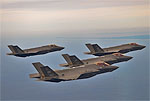AF expects F-35 upgrade, 2nd training squadron in the fall
 The Air Force’s F-35 program is expected to reach two major milestones this fall: the adoption of an advanced software and weapons system on the single-engine jet, and the beginning of major pilot training at the service’s second base for the fighter.
The Air Force’s F-35 program is expected to reach two major milestones this fall: the adoption of an advanced software and weapons system on the single-engine jet, and the beginning of major pilot training at the service’s second base for the fighter.
As of early September, 36 Air Force instructor pilots had finished training on the 14 conventional takeoff models that have been delivered to Eglin Air Force Base, Fla. The base in August surpassed more than 2,000 combined sorties on Air Force, Marine Corps and Navy variants.
“We are safely operating the aircraft and continuing to increase operations because we have well-trained maintainers and well-trained pilots,” said Col. Stephen Jost, commander of the 33rd Operations Group at Eglin.
Also in late August, maintenance crews at Eglin performed the first weapons load verification on the Air Force variant, loading and unloading laser-guided and GPS-guided bombs and air-to-air missiles. The verification will help officials write the training manuals for loading weapons on F-35s.
“We’re refining technical data that’s already written,” said Tech. Sgt. Lance Murphy, a crew chief in the 58th Maintenance Squadron. “Going in the proper sequence ... walking through an actual, physical load. Engaging munitions in the aircraft and making sure that everything is good to go. Everything works as advertised.”
This will set the standards for operations of live munitions in operational testing, which will then be refined and used for F-35 maintainer training back at Eglin.
The training program at Eglin is expected to begin operating the next software upgrade of the aircraft beginning in November, Block 2B. The software upgrade will include support for internal weapons, such as the AIM-120C missile and GBU-32/31 and GBU-21 bombs, according to the Defense Department.
The upgrade to Block 2B is the “biggest milestone” that Eglin officials are working toward. Once training begins on the new software system, pilots will need to fly three additional training sorties, along with additional academic sessions and time in flight simulators.
The Air Force earlier this year announced that it expects initial operating capability of the F-35A in December 2016, meaning at least 12 pilots trained on the Block 2B upgrade. The final software suite for full combat capability, Block 3F, is expected in 2017.
In June, Lt. Gen. Christopher Bogdan, head of the Joint Fighter Program, said he is “less than confident” that the final 2017 capability will be met on time due to delays.
In addition to the software upgrade this fall, the Air Force is expected to stand up pilot training at Luke Air Force Base, Ariz., in November. Last month, two instructor pilots and six crew chiefs transferred to the base to get the program started.
The squadron, the 61st Fighter Squadron, will start flying operations in the spring or early summer, Jost said. The Air Force expects 144 F-35s to eventually be assigned to the training center.
The base is currently the training center for F-16 pilots but will transfer its Falcons to Holloman Air Force Base, N.M., as the F-35s arrive.
The Air Force also is expected to stand up the F-35A maintenance depot at Hill Air Force Base, Utah, at the end of the year. Around that time, the service will announce its primary and preferred bases outside of the continental United States.
Last month, Gen. Herbert Carlisle, commander of Pacific Air Forces, said Eielson Air Force Base, Alaska, is the front-runner for the assignment.